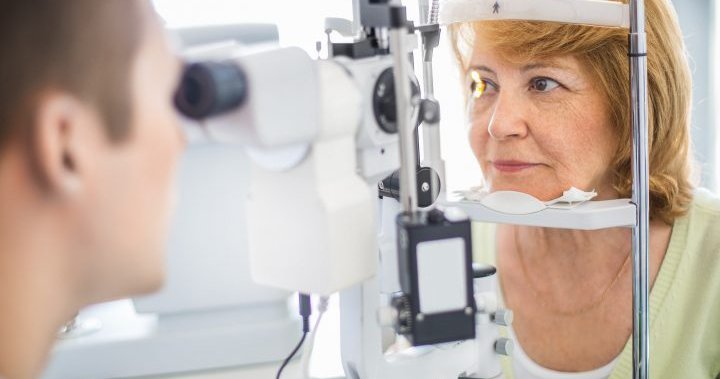Many Canadians are skipping regular eye exams. What are the risks? – National | Globalnews.ca
New polling shows many Canadians are skipping regular eye examinations despite having available coverage, raising concerns about the risks of diseases and long-term complications.
The findings from optical retail chain Specsavers released on Wednesday found nearly 50 per cent of the respondents said they have no plans to use their vision health benefits before the end of the year despite having coverage through their work or provincial health authority.
Read more:
Ignoring your eye health can lead to bigger problems down the road
Read More
-
![]()
Ignoring your eye health can lead to bigger problems down the road
One in four Canadians who do not wear glasses have not had an eye exam in over a decade, including 10 per cent who have never had their eyes checked, according to one of two online surveys conducted by Specsavers. Each survey included more than 1,500 Canadians and was completed in September and November.
The main reasons for not having a regular eye exam every two years were financial (33 per cent) and no complaints of vision problems or symptoms (22 per cent).
Doctors say it’s concerning because a lot of eye diseases and disorders can progress without people noticing any changes in their vision and a delay in diagnosis risks long-term damage.

“Regular routine examinations are really a necessary means of making sure we detect eye disease early and are able to treat it at a time when we can produce some positive effects,” said Brad Macario, an optometrist in British Columbia.
Canadian research shows 75 per cent of visual impairment is preventable if detected and treated early enough.
That should be motivation enough for people to get their eyes checked, Macario said.
“If things aren’t detected early enough, then we can’t really intervene as effectively as we would have had they (been) getting a routine yearly exam,” he told Global News.
What is a comprehensive eye exam?
Eye exams can start as early as six months and the Canadian Association of Optometrists recommends that infants and toddlers undergo their first examination before nine months.
Preschoolers between the ages of two and five should have at least one eye exam and annual check-ups are recommended for schoolchildren aged six to 19, as well as seniors 65 years and older.
Read more:
Eye exams should be part of back-to-school routine, specialists say
For adults aged 20 to 64, the recommendation by CAO is every two years.
A comprehensive eye examination not only determines the prescription for glasses or contact lenses, but it also checks the overall health of the eye to determine any risk factors for vision loss.

A non-invasive imaging test called optical coherence tomography (OCT) does a 3D scan of the eye, looking at the anatomy and the tissue well beyond what the human eye can detect, Macario said.
This test can help detect any types of vision-threatening diseases, he explained.
Eye movements, pressure in the eye, the lens, cornea and retina are also checked in routine exams, said Dr. Phil Hooper, president of the Canadian Ophthalmological Society.
“All of those aspects are very important to detect disease at an early stage if it’s present, and hopefully more treatable at that stage.”
Risks of skipping eye exams
The COVID-19 pandemic has resulted in many Canadians delaying or forgoing their eye examinations amid concerns about the virus spread, doctors say.
“We’ve had this massive gap where people just have completely put examinations off to the side and haven’t really made it a priority,” Macario said.
Early on, strict lockdowns restricted access to eye care in some jurisdictions. But now more people are coming in for a routine examination, Macario said .
Read more:
Put eye exams back on to-do list: Ophthalmologists see more vision problems in kids after increased screen time
Increased screen time during the pandemic has also increased eye issues in kids, optometrists say.
A majority (57 per cent) of those surveyed by Specsavers said that worsening vision over time would lead them to increase how often they get their eyes checked.
But it seems many do wait until they have an issue before they get a checkup; a diagnosed condition, unusual vision issues, such as blurring and spots, as well as eye pain were other leading reasons for getting an eye exam.
There is a “major impact of delaying” screening if you have an underlying problem, such as diabetes, Hooper said.

He said blurred vision can be the result of the development of diabetic retinopathy — an eye disease caused by high blood sugar — as well as macular degeneration – when part of the retina is damaged due to aging — in older individuals.
The chance of glaucoma, which is a loss of peripheral vision, also increases with age and this can go undetected because its symptoms don’t show up in the early stage of the disease, Hooper said.
Read more:
What is age-related macular degeneration and why should older Canadians care?
“If you wait in glaucoma until you have symptoms, you’re already going to be severely impaired right at the outset,” Hooper told Global News.
A recent survey by the Canadian Ophthalmological Society and the Canadian Association of Optometrists showed 41 per cent of people have experienced or been diagnosed with one or more changes to their eye health over the past two years which would require a comprehensive exam.
There is also a lack of awareness about eye health and disease among Canadians, the report published in October found.
Hooper said a broad approach across different forums and a joint effort from provinces and the federal government are needed to get the message across.
© 2022 Global News, a division of Corus Entertainment Inc.
For all the latest health News Click Here



